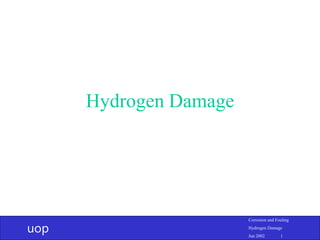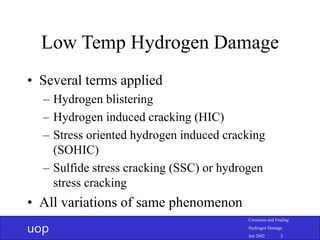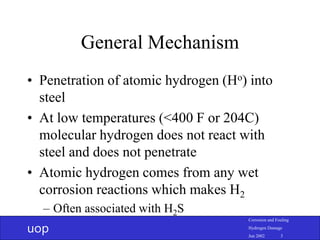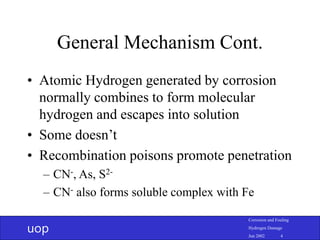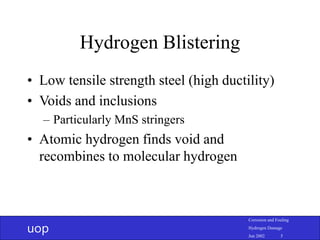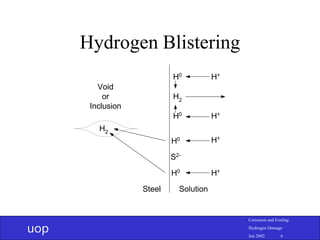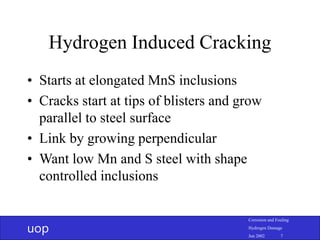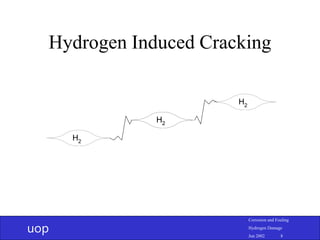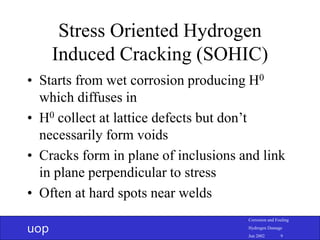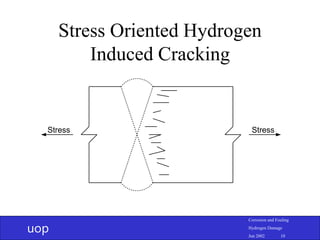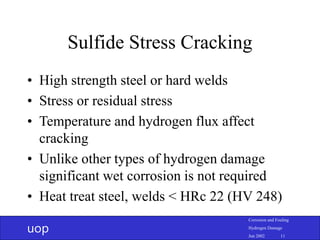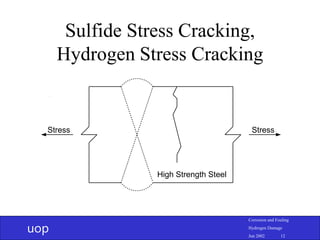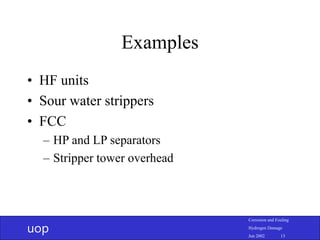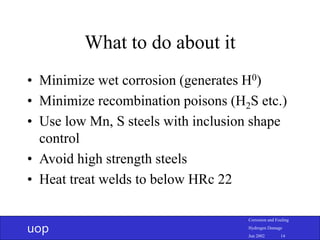04f Hydrogen Damage.ppt
- 1. uop Corrosion and Fouling Hydrogen Damage Jun 2002 1 Hydrogen Damage
- 2. uop Corrosion and Fouling Hydrogen Damage Jun 2002 2 Low Temp Hydrogen Damage ŌĆó Several terms applied ŌĆō Hydrogen blistering ŌĆō Hydrogen induced cracking (HIC) ŌĆō Stress oriented hydrogen induced cracking (SOHIC) ŌĆō Sulfide stress cracking (SSC) or hydrogen stress cracking ŌĆó All variations of same phenomenon
- 3. uop Corrosion and Fouling Hydrogen Damage Jun 2002 3 General Mechanism ŌĆó Penetration of atomic hydrogen (Ho) into steel ŌĆó At low temperatures (<400 F or 204C) molecular hydrogen does not react with steel and does not penetrate ŌĆó Atomic hydrogen comes from any wet corrosion reactions which makes H2 ŌĆō Often associated with H2S
- 4. uop Corrosion and Fouling Hydrogen Damage Jun 2002 4 General Mechanism Cont. ŌĆó Atomic Hydrogen generated by corrosion normally combines to form molecular hydrogen and escapes into solution ŌĆó Some doesnŌĆÖt ŌĆó Recombination poisons promote penetration ŌĆō CN-, As, S2- ŌĆō CN- also forms soluble complex with Fe
- 5. uop Corrosion and Fouling Hydrogen Damage Jun 2002 5 Hydrogen Blistering ŌĆó Low tensile strength steel (high ductility) ŌĆó Voids and inclusions ŌĆō Particularly MnS stringers ŌĆó Atomic hydrogen finds void and recombines to molecular hydrogen
- 6. uop Corrosion and Fouling Hydrogen Damage Jun 2002 6 Hydrogen Blistering S2- H+ H+ H+ H+ H0 H0 H0 H0 H2 H2 Void or Inclusion Steel Solution
- 7. uop Corrosion and Fouling Hydrogen Damage Jun 2002 7 Hydrogen Induced Cracking ŌĆó Starts at elongated MnS inclusions ŌĆó Cracks start at tips of blisters and grow parallel to steel surface ŌĆó Link by growing perpendicular ŌĆó Want low Mn and S steel with shape controlled inclusions
- 8. uop Corrosion and Fouling Hydrogen Damage Jun 2002 8 Hydrogen Induced Cracking H2 H2 H2 H2
- 9. uop Corrosion and Fouling Hydrogen Damage Jun 2002 9 Stress Oriented Hydrogen Induced Cracking (SOHIC) ŌĆó Starts from wet corrosion producing H0 which diffuses in ŌĆó H0 collect at lattice defects but donŌĆÖt necessarily form voids ŌĆó Cracks form in plane of inclusions and link in plane perpendicular to stress ŌĆó Often at hard spots near welds
- 10. uop Corrosion and Fouling Hydrogen Damage Jun 2002 10 Stress Oriented Hydrogen Induced Cracking Stress Stress
- 11. uop Corrosion and Fouling Hydrogen Damage Jun 2002 11 Sulfide Stress Cracking ŌĆó High strength steel or hard welds ŌĆó Stress or residual stress ŌĆó Temperature and hydrogen flux affect cracking ŌĆó Unlike other types of hydrogen damage significant wet corrosion is not required ŌĆó Heat treat steel, welds < HRc 22 (HV 248)
- 12. uop Corrosion and Fouling Hydrogen Damage Jun 2002 12 Sulfide Stress Cracking, Hydrogen Stress Cracking Stress Stress High Strength Steel
- 13. uop Corrosion and Fouling Hydrogen Damage Jun 2002 13 Examples ŌĆó HF units ŌĆó Sour water strippers ŌĆó FCC ŌĆō HP and LP separators ŌĆō Stripper tower overhead
- 14. uop Corrosion and Fouling Hydrogen Damage Jun 2002 14 What to do about it ŌĆó Minimize wet corrosion (generates H0) ŌĆó Minimize recombination poisons (H2S etc.) ŌĆó Use low Mn, S steels with inclusion shape control ŌĆó Avoid high strength steels ŌĆó Heat treat welds to below HRc 22

